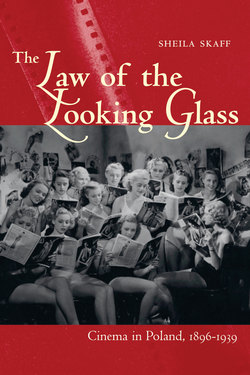Читать книгу The Law of the Looking Glass - Sheila Skaff - Страница 9
На сайте Литреса книга снята с продажи.
ОглавлениеSeries Editor’s Preface
POLISH FILM AND CINEMATOGRAPHY rank among the leading examples of the cinematic arts in the late twentieth century. Sheila Skaff’s excellent revisionist study, The Law of the Looking Glass: Cinema in Poland, 1896–1939, examines the background and development of cinema and cinematography in Poland from their earliest moments in the late nineteenth century through the late nineteen thirties, when world war and political change created a dramatic break with the past and launched the country into a new phase of filmmaking practice.
Skaff’s book offers a thorough look at a subject that has yet to be studied in depth by more than a handful of scholars, possibly because of the extensive linguistic and technical expertise required to approach it credibly. The book, according to Skaff, “attempts to recapture the multilingualism and social diversity of cinema in the partitioned lands and independent Poland.” Indeed, rather than narrowing her own cinematic gaze and succumbing to the temptation to focus exclusively on Polish-language cinema and its relationship to Polish nationalism and nation building, Skaff wisely examines the cinematic traditions and practices among filmmakers of various ethnocultural and linguistic backgrounds in a multiethnic pre-1939 Poland. Her revisionist approach will earn the book a central place in the canon of Polish film studies. Her choice of an ending date for her study is a wise one, as well. World War II decimated the ranks of Polish filmmakers, and after the war the new Communist government nationalized the Polish film industry, bringing the chaotic-dynamic prewar era to a quiet close. Despite this obvious rupture with the cinematic tradition of the prewar years, Skaff nonetheless shows the carryover of important artistic influences and sensibilities, successfully making the argument that “this cultivation of the art of looking has proven a revered tradition that reaches to the beginning of the twenty-first century.”
For a volume so rich in information, the book is gracefully written and jargon-free. In this important and provocative study, Skaff displays a solid knowledge of Polish history, ambitious coverage of her topic, originality, and what one reader has called an “unmistakable passion for Polish film.” The Law of the Looking Glass: Cinema in Poland, 1896–1939 is a valuable work that will find a broad audience among students of Polish history, film scholars, and film buffs alike.
Publication of the Ohio University Press Polish and Polish-American Studies Series marks a milestone in the maturation of the Polish studies field and stands as a fitting tribute to the scholars and organizations whose efforts have brought it to fruition. Supported by a series advisory board of accomplished Polonists and Polish-Americanists, the Polish and Polish-American Studies Series has been made possible through generous financial assistance from the Polish American Historical Association, the Polish Institute of Arts and Sciences of America, the Stanislaus A. Blejwas Endowed Chair in Polish and Polish American Studies at Central Connecticut State University, and the Piast Institute and through institutional support from Wayne State University and Ohio University Press. The series meanwhile has benefited from the warm encouragement of a number of other persons, including Gillian Berchowitz, M. B. B. Biskupski, the late Stanislaus A. Blejwas, Mary Erdmans, Thaddeus Gromada, James S. Pula, Thaddeus Radzilowski, and David Sanders. The moral and material support from all of these institutions and individuals is gratefully acknowledged.
John J. Bukowczyk
